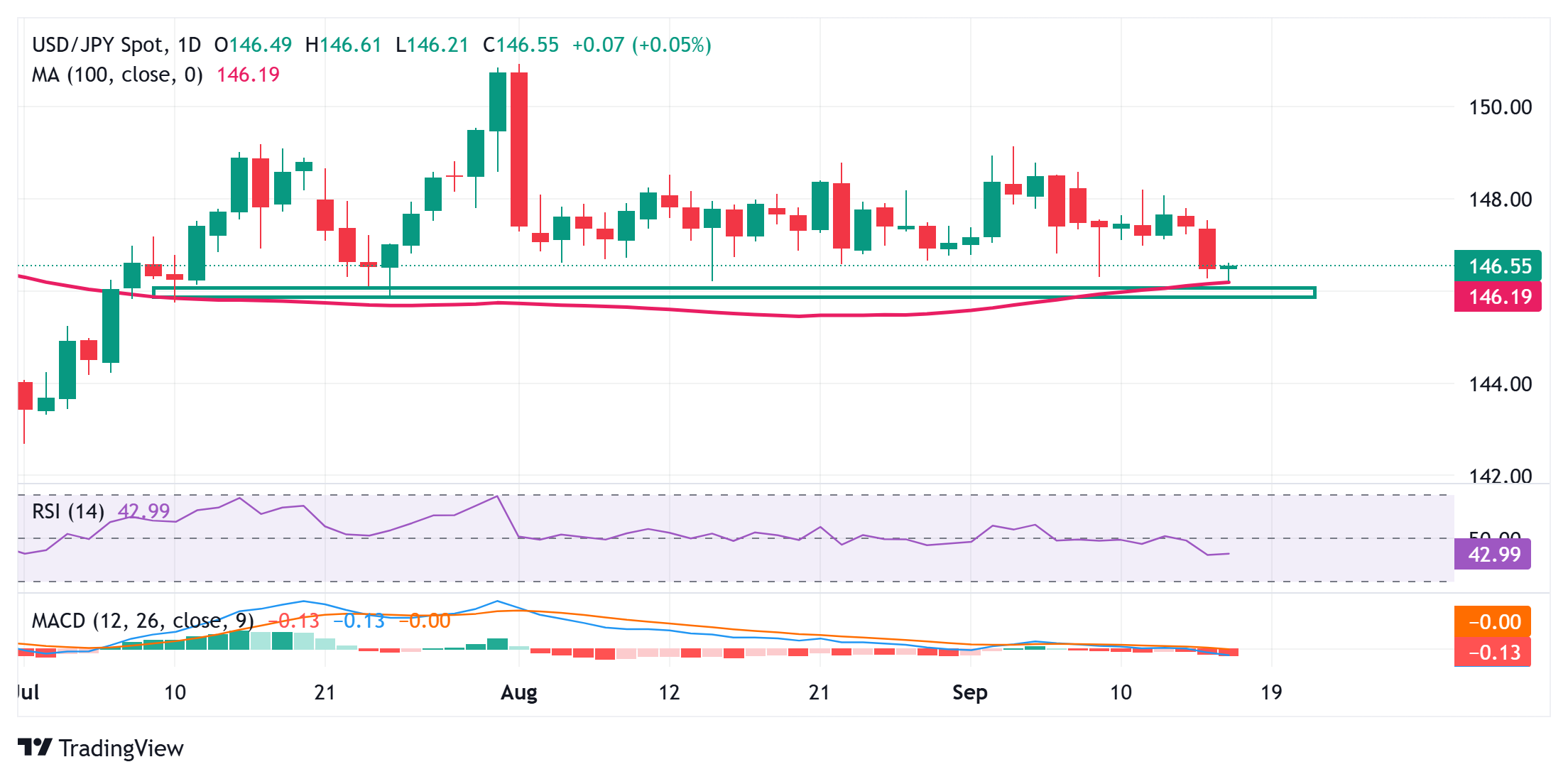Japanese Yen holds steady against USD as traders await key Fed and BoJ policy decisions
- The Japanese Yen bulls turn cautious amid a modest USD bounce during the Asian session.
- The divergent BoJ-Fed policy expectations and the cautious mood could benefit the JPY.
- Traders might also opt to wait for the key FOMC decision later today and the BoJ meeting.
The Japanese Yen (JPY) holds steady against a broadly rebounding US Dollar (USD) and remains close to its highest level since July 24, touched during the Asian session on Wednesday. Traders now seem reluctant and keenly await key central bank events before positioning for the next leg of a directional move. The US Federal Reserve (Fed) is scheduled to announce its decision later today, which will be followed by a two-day Bank of Japan (BoJ) policy meeting starting Thursday. The policy outlooks will play a key role in influencing the near-term trajectory for the USD/JPY pair.
In the meantime, the growing market conviction that the BoJ will stick to its policy normalization path, along with the cautious market mood, seems to act as a tailwind for the safe-haven JPY. Furthermore, rising bets for a more aggressive policy easing by the Fed and the resultant narrowing of the US-Japan rate differential should contribute to limiting the downside for the lower-yielding JPY. That said, a modest USD bounce from its lowest level since early July should offer some support to the USD/JPY pair and warrants caution before positioning for any further depreciating move.
Japanese Yen traders seem non-committed ahead of key central bank events; bullish bias remains
- A government report released earlier this Wednesday showed that Japan’s trade deficit widened sharply from ¥118.4 billion to ¥242.5 billion in August. This, however, was less than a deficit of ¥513.6 billion anticipated as exports shrank less than expected, by 0.1% compared to forecasts for a drop of 1.9% and a 2.6% fall recorded in July, as the finalization of the US-Japan trade deal offered some clarity to exporters.
- Other details of the report revealed that Japanese imports shrank far more than expected, by 5.2% during the reported month, and pointed to still weak domestic demand. Moreover, Japanese Prime Minister Shigeru Ishiba’s resignation added a layer of uncertainty and could give the Bank of Japan more reasons to go slow on interest rate hikes. Hence, focus remains glued to the BoJ policy meeting starting Thursday.
- The Japanese central bank is expected to leave the benchmark interest rate unchanged at 0.5% amid domestic headwinds and global risks, including the effects of US tariffs. Investors, however, seem convinced that the BoJ will hike interest rates by the end of this year. In contrast, the US Federal Reserve is anticipated to resume its rate-cutting cycle and lower borrowing costs by 25 basis points later this Wednesday.
- Moreover, traders have been pricing in the possibility of two more rate cuts by the Fed this year amid signs of a softening labor market. This had been a key factor behind the recent US Dollar slide to its lowest level since early July touched this Thursday and dragged the USD/JPY pair to the 146.20 support zone during the Asian session. Traders, however, opt to wait for the highly anticipated FOMC decision later today.
- US President Donald Trump intensified his calls for a resolution to the Russia-Ukraine conflict, urging Ukrainian President Zelensky to make a deal to end the war and pressing Europe to immediately stop buying Russian oil. This comes after Russian forces launched a massive attack on Ukraine’s southeastern city of Zaporizhzhia, following a series of strikes by the latter against its oil infrastructure in recent weeks.
- Meanwhile, Israel launched its long-planned ground assault on Gaza City and its troops have pressed deep into the densely populated city on Tuesday, which has been subjected to intense bombardment for weeks. Moreover, an emergency summit of Arab and Islamic country leaders had condemned Israel’s attack on Hamas leaders in Qatar’s capital, Doha, on September 9. This, in turn, keeps geopolitical risks in play.
USD/JPY finds some support near 146.20, not of the woods yet

From a technical perspective, the overnight breakdown and acceptance below the 147.00 mark was seen as a fresh trigger for the USD/JPY bears. Moreover, oscillators on the daily chart have again started gaining negative traction, suggesting that the path of least resistance for spot prices remains to the downside. That said, a modest bounce from the 146.20 horizontal support, also representing the 100-day Simple Moving Average (SMA), warrants some caution. Hence, it will be prudent to wait for some follow-through selling below the said area and the 146.00 mark, before positioning for any further losses. The pair might then accelerate the downfall towards the 145.35 intermediate support en route to the 145.00 psychological mark.
On the flip side, any subsequent recovery beyond the 146.70 immediate hurdle is likely to attract fresh sellers and remain capped near the 147.00 round figure. Some follow-through buying beyond the 147.15-147.20 region, however, could lift the USD/JPY pair beyond the 147.55 hurdle, towards the 148.00 mark. A sustained strength beyond the latter might trigger a short-covering move towards the 200-day Simple Moving Average (SMA), currently pegged near the 148.75 zone. This is followed by the 149.00 mark and the monthly high, around the 149.15 region, which, if cleared decisively, would shift the near-term bias in favor of bullish traders.




